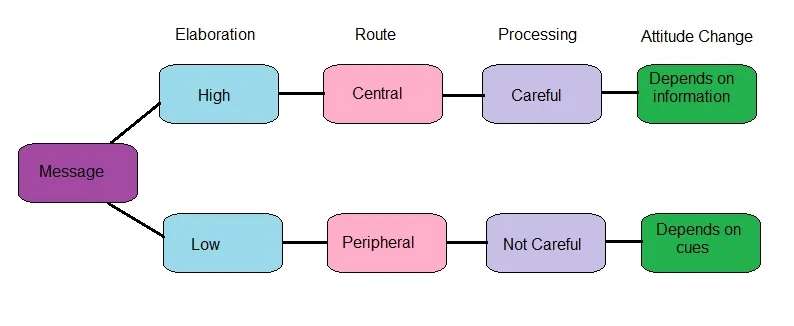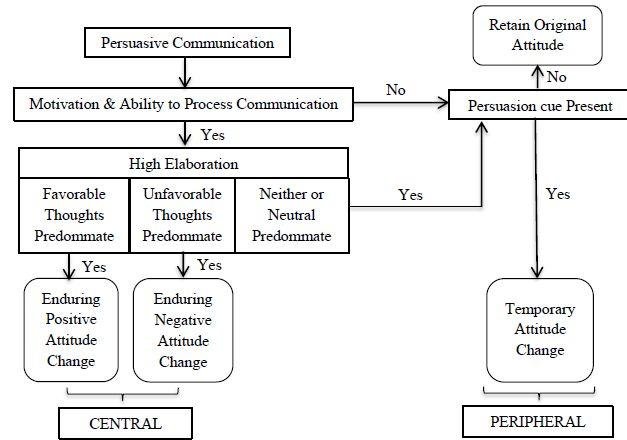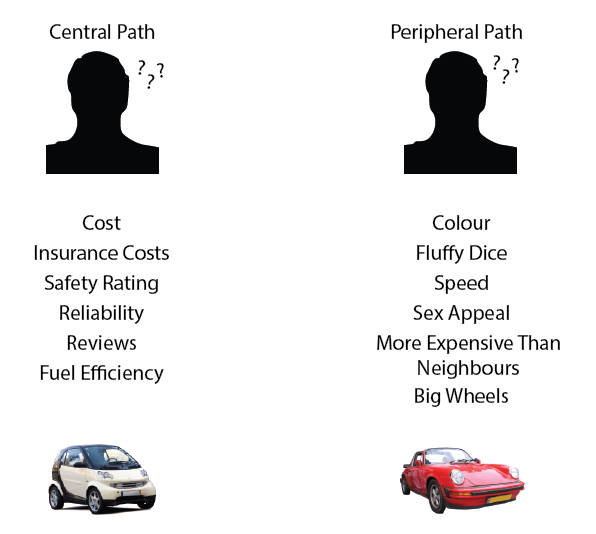Introduction
The Elaboration Likelihood Model (ELM) is a widely used theory in the field of communication and marketing. It was developed in the 1980s by Richard E. Petty and John T. Cacioppo and has been extensively studied and applied in various contexts. The ELM posits that persuasion occurs through two routes: the central and peripheral routes. The central route involves a deep level of processing and evaluation of the message, while the peripheral route relies on superficial cues and heuristics. The level of elaboration, or cognitive processing, depends on the receiver’s motivation and ability to process the message.

The elaboration likelihood model seeks to explore how humans process stimuli differently and how the outcomes of these processes result in changing attitudes and, consequently, behavior.
Core Assumptions and Statements
The ELM is based on the idea that attitudes are important because attitudes guide decisions and other behaviors. While attitudes can result from a number of things, persuasion is a primary source. The model features two routes of persuasive influence: central and peripheral. The ELM accounts for the differences in persuasive impact produced by arguments that contain ample information and cogent reasons as compared to messages that rely on simplistic associations of negative and positive attributes to some object, action or situation. The key variable in this process is involvement, the extent to which an individual is willing and able to ‘think’ about the position advocated and its supporting materials. When people are motivated and able to think about the content of the message, elaboration is high. Elaboration involves cognitive processes such as evaluation, recall, critical judgment, and inferential judgment. When elaboration is high, the central persuasive route is likely to occur; conversely, the peripheral route is the likely result of low elaboration. Persuasion may also occur with low elaboration. The receiver is not guided by his or her assessment of the message, as in the case of the central route, but the receiver decides to follow a principle or a decision-rule which is derived from the persuasion situation.
Conceptual Model

Applications of the Elaboration Likelihood Model
As the picture below shows, a person is considering buying a car and is persuaded by his friend to buy a certain model. If he processes his friend’s message by taking the central route, he will carefully evaluate his friend’s argument and rationally think about the cost, reliability, fuel efficiency of this model. Once he generates favorable thought along the central route, the ELM predicts he will accept the message and the result is enduring. However, if he uses the peripheral route to process the message, he will be likely to buy the car simply because he likes the color, or a famous idol on television “asks” him to buy this car. Compared to the central route’s effect, thoughts generated from the peripheral route will be relatively short-lasting.

An Elaboration Likelihood Model by Bhattacherjee and Sanford (2006) presented a framework for understanding the factors that influence information technology (IT) acceptance. The study found that the ELM could predict IT acceptance through both central and peripheral routes. The researchers suggested that IT acceptance could be improved by providing high-quality information, reducing perceived risk, and using credible sources of information.
Another study, The Elaboration Likelihood Model and Communication About Food Risks by Frewer, Howard, Hedderley, and Shepherd (1997), applied the ELM to understand how consumers process information about food risks. The study found that consumers were more likely to engage in central processing when the risk was perceived as high and the message was presented in a credible manner. The researchers recommended that risk communication should be tailored to the audience’s motivation and ability to process information.
The ELM has also been applied to advertising research. An Application of the Elaboration Likelihood Model by Gotlieb and Swan (1990) examined how message content, source credibility, and message complexity affected consumers’ attitudes towards an advertisement. The study found that consumers were more likely to process a message centrally when the source was credible and the message was complex. In contrast, consumers were more likely to rely on peripheral cues when the message was simple.
Despite its wide use and application, the ELM has also received criticism. One limitation is that it assumes that people are rational and motivated to process information. However, this is not always the case, as people may be biased or have limited attention and cognitive resources. Additionally, the ELM focuses primarily on cognitive processing and does not consider emotional or affective responses to persuasion messages.
Criticism
A big flaw compared to similar models/theories/frameworks One criticism of the ELM is that it focuses on individual-level processing and does not consider social or cultural factors that may influence persuasion. The Social Judgment Theory, for example, posits that persuasion is influenced by the receiver’s existing attitudes and perceptions, which are shaped by their social and cultural context. Similarly, the Cultural Cognitive Theory suggests that persuasion is shaped by cultural schemas and norms that guide information processing and evaluation.
Finally, the ELM has some limitations in its application to real-world contexts. One limitation is that it may be difficult to accurately measure the level of elaboration and processing that occurs in response to a message. Additionally, the ELM may not fully account for the complexity and diversity of individual attitudes and beliefs, which can vary across different contexts and situations.
In conclusion, the Elaboration Likelihood Model is a valuable tool for understanding persuasion and communication processes. Its emphasis on central and peripheral routes and the factors
References
Bhattacherjee, A., & Sanford, C. (2006). Influence Processes for Information Technology Acceptance: An Elaboration Likelihood Model. Management Information Systems Quarterly, 30(4), 805. https://doi.org/10.2307/25148755
Cacioppo, J.T. & Petty, R.E. (1979). Effects of message repetition and position on cognitive response, recall and persuasion. Journal of Personality and Social Psychology, 27, 97-109.
Cacioppo, J.T., Harking, S.G., and Petty, R.E. (1981). Attitude, Cognitive Response and Behavior, Cognitive Responses in Persuasion (31-77). New Jersey: Hillsdale.
Elaboration Likelihood Model of Persuasion. (2023, February 16). Simply Psychology. https://www.simplypsychology.org/elaboration-likelihood-model.html
Frewer, L. J., Howard, C., Hedderley, D., & Shepherd, R. (1997). The Elaboration Likelihood Model and Communication About Food Risks. Risk Analysis, 17(6), 759–770. https://doi.org/10.1111/j.1539-6924.1997.tb01281.x
Gotlieb, J. B., & Swan, J. E. (1990). An Application of the Elaboration Likelihood Model. Journal of the Academy of Marketing Science. https://doi.org/10.1177/009207039001800304
Kitchen, P. J., Kerr, G., Schultz, D. E., McColl, R., & Pals, H. (2014). The elaboration likelihood model: review, critique and research agenda. European Journal of Marketing, 48(11/12), 2033–2050. https://doi.org/10.1108/ejm-12-2011-0776
Morris, J. B., Woo, C., & Singh, A. J. (2005). Elaboration likelihood model: A missing intrinsic emotional implication. Journal of Targeting, Measurement and Analysis for Marketing, 14(1), 79–98. https://doi.org/10.1057/palgrave.jt.5740171
Petty, R. E. (1984). Source Factors and the Elaboration Likelihood Model of Persuasion. ACR. https://www.acrwebsite.org/volumes/6328/
Petty, R.E. & Cacioppo, J.T. (1986). The Elaboration Likelihood Model of persuasion. New York: Academic Press.
Petty, R.E., and Krosnick, J.A. (1995). Attitude strength: Antecedents and consequences. Mahwah, NJ: Erlbaum Associates.
Petty, R.E. & Wegener, D.T. (1998). Attitude change. In Gilbert, D., Fiske, S. & Lindzey, G. (Eds.). The Handbook of Social Psychology (4th ed.). New York: McGraw-Hill.
Petty, R. E., Kasmer, J. A., Haugtvedt, C. P., & Cacioppo, J. T. (1987). Source and message factors in persuasion: A reply to stiff’s critique of the elaboration likelihood model. Communication Monographs, 54(3), 233–249. https://doi.org/10.1080/03637758709390229